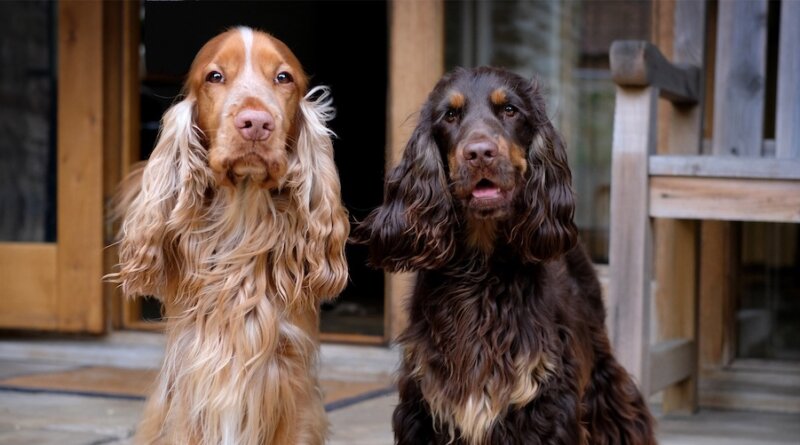Everything Your Need to Know About English Cocker Spaniels

In the latest in our series of dog breed guides, Natalia Ashton, author of Perfect Cocker Spaniel, shares everything you need to know about these beautiful dogs.
With its silky ears, expressive eyes and scrumptious paws, it’s no wonder the cocker spaniel has conquered the hearts of the world’s thinkers and creatives. From Shakespeare to Rudolph Valentino, Elizabeth Taylor to Marilyn Monroe, and not forgetting the Duke and Duchess of Cambridge, the English Cocker Spaniel has amassed a crowd of loyal fans. And who could blame them?
Have you ever dreamed of having one of these merry little dogs? Read on before joining the pack.

TEMPERAMENT
A happy, goofy cocker bursts into your life like a hurricane of joy. He is likely bearing gifts, too, because many spaniels love to carry something wherever they go… a tennis ball, a stick or their favourite trophy sock stolen from the master’s draw.
Beautiful, very smart and occasionally stubborn, cockers are the Teddy Bears of the canine world. They love their families and adore people, who they greet with a wagging tail, wiggly bottom and a generous helping of kisses.
They can comfortably share their home with other pets, but nobody will ever replace the object of their true affection, the human parents. Cockers will love them unconditionally and faithfully trot along to the end of the universe to be together forever.
English cockers loathe being alone and can develop separation anxiety if not handled with care during puppyhood. Their ideal family need to include people who can work from home or take the spaniel to work with them – solitude will break the cocker’s heart.

Even though they are soft-natured and can’t help but love a long snuggle and an ear rub, even the sweetest spaniel still has a gun dog inside him, ready to burst out for daily adventures. Training an English cocker is a very rewarding and enjoyable experience. They can pick up the basic commands within days, though may struggle with loose lead walking because being ahead and following the scent is in their DNA. Barking can also be an issue for some. The trait tends to run in families and you can prevent potential issues by meeting the puppy’s parents and asking a breeder about their character and habits.
APPEARANCE
First and foremost it’s important to mention
that English cocker spaniels are divided into two types. The show type
dogs are sturdy, have a beautiful domed head, square muzzle, low-set ears and
long silky coat. This strain is the one most people associate with a typical
cocker spaniel.
The working cocker is similar to the
Field spaniel. These dogs are very athletic, have a wider head, long muzzle and
short, slightly pointy low-set ears. The coat of a working cocker is silky, but
short and has very little feathering.
Cockers come in a great variety of colours
including solid shades of gold, chocolate and red, bi-colours such as black and
white or white and gold, roans (when the white and coloured hair create a
melange effect), tri-colours, parti-colours (a mixture of two or more solid
colours one of which is white) and sable.
Size-wise, all spaniels are compact
medium-sized dogs, about 39-42cm in withers and 12-14.5kg in weight, which make
them a perfect companion for all family members.

EXERCISE
The wonderful thing about cockers is that
they are a true lifestyle breed. The dog can walk with you for miles, yet be
satisfied with two half-hour walks daily. Remember to indulge his innate need
to sniff every spot along the way – and sometimes return to it over and over
again before you can move on.
Many cockers love running and make fantastic agility partners, too. Just let them grow and mature first as any strenuous exercise before the age of at least 18 months can increase the risk of bone disorders in the future.
Always mix physical exercise with mental stimulation in a form of puzzle games, licky-mats, chews and food-dispensing toys. The balance you achieve will calm even the most hyperactive spaniel.
English cockers loathe being alone and can develop separation anxiety if not handled with care during puppyhood.
LIVING ENVIRONMENT
English cockers are adaptable and can live in a city flat, but the real comfort in every cocker’s eyes comes with a house and a garden. Essentially, cockers are the countryside dogs and love field trips with the passion of a true English gent. At home, they are rather fond of comfy beds and sofas. Unless you have incredibly strong willpower, your dog will soon sneak into your bed and your lap, and you are likely to fail to stop him; having a little spaniel napping next to you is an addictive experience.
GROOMING
If you love the look of a long silky coat, be prepared to work hard to keep it that way. Cockers may not need a weekly bath, but the beautiful hair requires daily grooming, washing, blow-drying and brushing. You will also need to trim the paws and ears once a month and check them for seeds and grass after every walk.
Once every 2-4 months the cocker should be
hand-stripped. You can learn to do it yourself or find an experienced groomer.
Avoid clipping your dog because it will
likely destroy his coat forever turning it from silky to curly and prone to
knots.

HEALTH
English cockers are a very healthy breed. To avoid any problems, ensure that the puppy comes from parents tested for AMS (Acral Mutilation Syndrome) – insensitivity to pain leading to self-mutilation, prcd-PRA (Progressive Retinal Atrophy) – degeneration of the retina and subsequent blindness and FN (Familial Nephropathy) – irreversible kidney failure and, ideally, hip-scored before mating. The mandatory health-scheme can be found on the Kennel Club website. You can also obtain the test results through the KC Mate Select, an on-line database of all dogs used for breeding. Any breeder should be able to provide the copies of the health test certificates upon request.
Cockers are also known as one of the breeds prone to hip dysplasia (partial or complete dislocation of the hip joint), distichiasis (abnormal growth of the eyelashes) and haemolytic anaemia (a sudden breakdown of the red blood cells by the immune system).
Ear inflammation (otitis) and lip fold
dermatitis (inflammation of the lip) are some of the common health complaints
but can be completely avoided with the right care.
English cockers love their food and can easily put on weight. You will need to be very precise when it comes to feeding times and quality and number of daily treats.
Want to know more about this lovable breed? Get a copy of Natalia’s book – Perfect Cocker Spaniel – a personal yet comprehensive guide for all prospective puppy parents and true lovers of the breed. Follow her cockers @cooper.spaniel & @fred.the.spaniel on Instagram.




